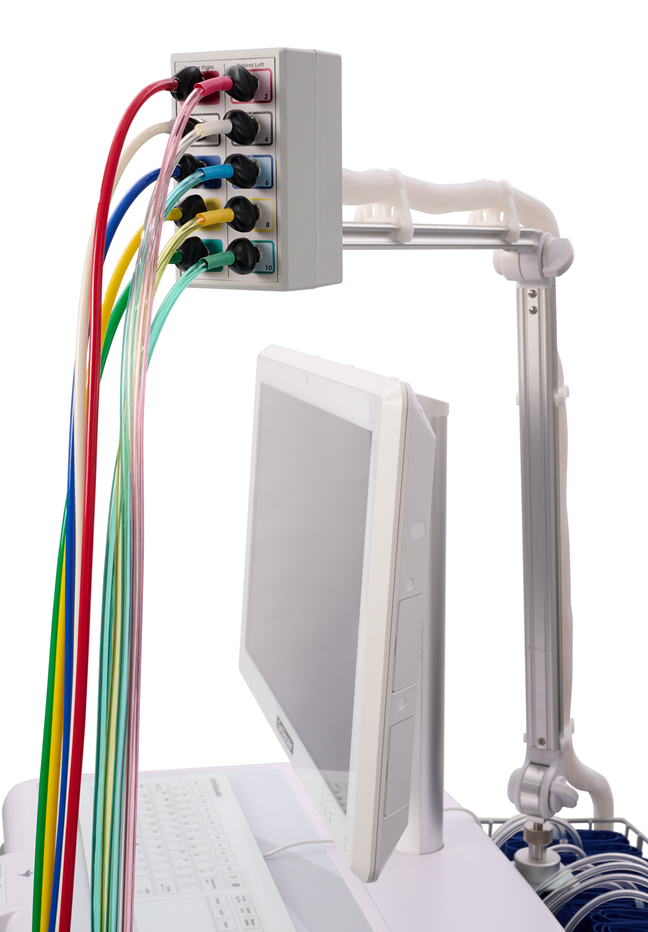Calibrated Pulse Volume Recording (PVR)
This unique feature allows clinicians to immediately identify improper cuff wrapping by comparing the volume of air in each cuff, preventing subsequent incorrect blood pressure values that could lead to misdiagnosis.

Calibrated Pulse Volume Recording (PVR) is a non-invasive vascular diagnostic technique that provides precise, quantitative assessment of blood flow in the limbs. Using blood pressure cuffs, VasoGuard systems deliver highly reliable and reproducible results for vascular health assessment with real-time display of accumulated air in each cuff.
| Cuff Wrapping Issue | Blood Pressure Error | Clinical Impact |
|---|---|---|
| Cuff too loose | +10 to +30 mmHg systolic | False hypertension diagnosis |
| Cuff too tight | -5 to -15 mmHg systolic | Missed hypertension |
| Cuff over clothing | +5 to +15 mmHg systolic | Inaccurate baseline readings |
| Wrong cuff size | ±10 to ±20 mmHg | Systematic measurement errors |
| Cuff positioned incorrectly | ±5 to ±25 mmHg | Variable, unpredictable errors |

Pulse Volume Recording (PVR) is a non-invasive vascular test that measures blood pressure and blood flow in the legs using blood pressure cuffs. According to the Cleveland Clinic, PVR tests use ultrasound (high-frequency sound waves) to evaluate circulation in arteries and can help diagnose peripheral artery disease (PAD) and locate blood clots or blockages. A PVR waveform is a graphical representation of blood volume changes in a limb over time, generated during the test. The resulting waveform's shape, particularly its rapid upstroke, well-defined peak, dicrotic notch, and gradual downstroke, helps assess the health of peripheral arteries. VasoGuard's calibrated PVR takes this a step further by providing real-time air volume measurements in cubic centimeters (cc), allowing clinicians to see the actual volume of air in each cuff during testing.
- Non-invasive and painless for the patient
- Provides both qualitative waveforms and quantitative data
- Essential for diagnosing peripheral arterial disease (PAD) and other vascular conditions
- Live monitoring of air volume in each cuff during testing
- Real-time cc values displayed for each limb segment
- Comparison of cc values between cuffs reveals improper wrapping
- Differences in cc values indicate potential measurement errors
- Immediate feedback prevents incorrect blood pressure readings
- Objective data for ensuring test accuracy and reliability

According to the Cleveland Clinic, PVR tests place blood pressure cuffs on the big toes, ankles, calves, upper and lower thighs, and arms. The cuffs are inflated to measure blood pressure, and a handheld transducer applies ultrasound waves to different parts of the leg. The sound waves measure the speed and volume of blood moving through the legs, with results appearing as waveforms on a computer monitor. VasoGuard's calibrated PVR enhances this process by providing real-time air volume measurements in cc's for each cuff, allowing immediate detection of improper wrapping that could affect measurement accuracy.
- Automated calibration for every channel and test
- High-fidelity pressure measurement for accurate readings
- Real-time waveform display and data export
- Real-time cc values for each cuff during segmental assessment
- Comparison of cc values between cuffs reveals wrapping inconsistencies
- Differences in cc values indicate improper cuff placement
- Immediate correction prevents subsequent incorrect measurements
- Ensures consistent, reliable results across all tests
Proper cuff wrapping is critical for accurate PVR measurements. VasoGuard's unique ability to display the volume of air in each cuff (in cc's) provides immediate visual feedback, allowing clinicians to identify and correct improper wrapping before it affects measurement accuracy.
Calibrated PVR is a cornerstone of modern vascular diagnostics. It is especially valuable for:
- Detecting and grading peripheral arterial disease (PAD)
- Assessing arterial occlusions and stenosis
- Monitoring post-intervention outcomes
- Evaluating limb perfusion in diabetic and high-risk patients
- Supporting clinical decision-making with objective, reproducible data
The ability to obtain calibrated, quantitative results sets VasoGuard apart, providing clinicians with the confidence to diagnose and manage vascular disease at the highest standard of care.
VasoGuard systems feature state-of-the-art calibrated PVR technology:
- Independent, calibrated pressure channels for each limb
- Real-time cc air volume display for each cuff during testing
- Automated workflow and intuitive user interface
- Comprehensive data export for EMR and research
- Continuous software updates and support
With VasoGuard, clinicians benefit from a robust, user-friendly platform that delivers both clinical accuracy and operational efficiency.
Calibrated Pulse Volume Recording is the gold standard for non-invasive vascular assessment. Its ability to provide both qualitative and quantitative data makes it indispensable for modern vascular labs. VasoGuard's implementation ensures that every test is accurate, repeatable, and easy to perform, supporting better patient outcomes and streamlined clinical workflows.
- Gold standard for PAD diagnosis and monitoring
- Trusted by vascular specialists and sonographers
- Seamless integration with other diagnostic modalities
- Backed by CorVascular's commitment to innovation and support
- Unique real-time cc air volume display for each cuff
- Immediate detection of improper cuff wrapping through air volume comparison